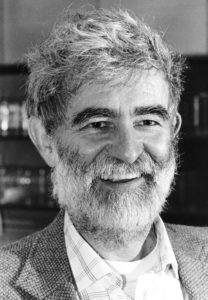John Moline Teal
The Woods Hole Oceanographic Institution announces with great sorrow the death of WHOI scientist emeritus, ecologist, oceanographer, and writer John Moline Teal, on June 14, 2024, at his at home in Rochester, Massachusetts. He was 94.

John was born November 9, 1929, in Omaha, the son of Clarence William Teal, an electrical engineer and Assistant VP for Northwestern Bell Telephone Company, and Valentine Moline Teal, a writer of children’s books and comic short stories for the Ladies Home Journal, the Woman’s Home Companion, and the Saturday Evening Post. He attended Harvard College where he received his bachelor’s degree magna cum laude, and, four years later, a Ph.D. from Harvard University. Dr. Teal’s first career position was at the University of Georgia Marine Institute on Sapelo Island, where he lived with Mildred and their children Eric and Tanya. Following a two-year teaching position in Halifax, Nova Scotia, at Dalhousie University’s newly established Institute of Oceanography, in 1961 he took a position at WHOI, from which he retired in 1994.
Throughout his career, he worked to bring his scientific expertise to promote changes in national, state, and local policies and laws. He was a prolific writer, authoring or co-authoring more than 160 peer-reviewed scientific papers as well as four books, five encyclopedia articles, and several magazine articles for children about oceanography. His best-known book, Life and Death of the Salt Marsh, which he wrote with his first wife, Mildred Mann Teal, introduced the general public to the intricacies and ecological importance of salt marshes.
In 1983, he was one of twenty scientists who warned of a global climate catastrophe in “The Long-Term Effects of Nuclear War,” widely publicized at the time, for its prediction of a Nuclear Winter in the event of war. His research on the effects of oil spills on saltmarshes was pioneering and continues to be used as recently as 2022 in The National Academy of Science’s publication Oil in the Ocean IV: Inputs, Fates, and Effects. He loved going to sea, introducing younger scientists and students to the magic and rigors of sea-going oceanography. Research cruises to the Sargasso Sea in the 1970s and his research on oil spills in particular set the course of the careers of many graduate students and young scientists. He was active teaching, mentoring, and supporting graduate students in the WHOI-MIT Joint Doctoral Degree Program throughout his years at the Oceanographic.
John received the Lifetime Achievement Award of the Society of Wetland Scientists in 2007, the Estuarine Research Federation 1999 Odum Award and the Massachusetts Wetland Restoration Award in 1998. He sat on the editorial board of three scientific journals and was a board member and later president of the Society of Wetland Scientists. He also served on other boards and advisory committees including, The Pew Trust, the Minerals Management Service of the Department of Energy, and The Conservation Law Foundation (CLF), where John served on the Board of Directors for 35 years. He was Vice Chairman for many of those years. He founded CLF’s Science Advisory Board, gathering eminent scientists to assist in CLF cases. John was the lead expert witness and science advisor in many CLF lawsuits, including most notably, the successful battles to cleanup Boston Harbor, prevent oil drilling on the George’s Bank fishing grounds, and to ban off-road vehicles (ORVs) from the dunes and beaches of the Cape Cod National Seashore. John’s expert testimony in the ORV case was so persuasive that the government’s own witness asked to switch sides and support CLF’s arguments. Boston Harbor is now clean, Georges Bank is free of oil drilling, and ORVs are banned on the Cape Cod National Seashore, thanks in no small part to John’s science advocacy.
John’s professional career started at the University of Georgia Marine Institute (1955-1959) on Sapelo Island. He considered the island a living laboratory and developed techniques to study and measure the biogeochemical functions of salt marshes. Researchers involved in the Georgia Coastal Ecosystems Long-Term Ecological Research Project (GCE-LTER) still use the “Teal boardwalk” to access the marsh. After he retired from WHOI, he became a scientific advisor to Public Service Electric & Gas of New Jersey on their extensive coastal wetland restoration project around Delaware Bay and continued to work on that project until he retired in 2018.
Parallel to his professional career, he developed skills needed on his 150-acre farm. He became master of plumbing, carpentry, cabinetry, clock-making, forestry, and farming. He was an avid birdwatcher with an impressive life list. He loved music of all kinds, especially classical music, from medieval chansons onward, and American musical theater. He played the piano and the organ. And he sang as an undergraduate in the Harvard Glee Club, where they performed with the Boston Symphony Orchestra under Serge Koussevitzky. He spent the last half of his life on the farm and in the house he and his second wife Susan had built from little but forest and fallow fields.
He is survived by his wife, Susan Blackmore Peterson Teal, an anthropologist, a brother, Thomas Teal of Somerville MA, a sister, Alison Teal Brown of Key West FL, and by two children, four grandchildren, and three great-grandchildren. John also leaves a host of devoted relatives, friends, and colleagues.
Contributions in his memory may be made to the Conservation Law Foundation of New England (CLF.org), the Rochester Land Trust (rochesterlandtrust.org), or Woods Hole Oceanographic Institution (WHOI.edu). Following the example set by his parents, John has donated his body to the Warren Alpert Medical School of Brown University.
Information for this obituary is from the Teal family
